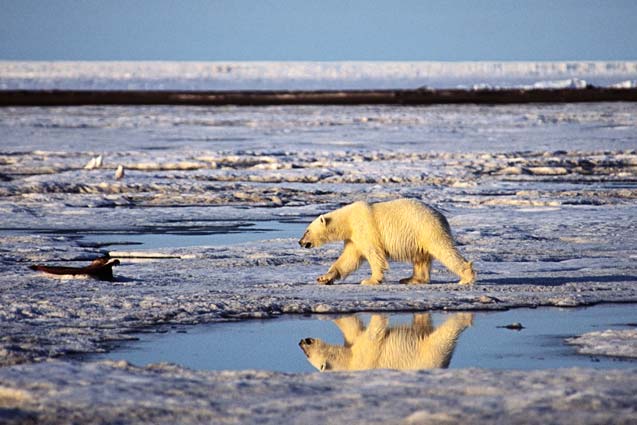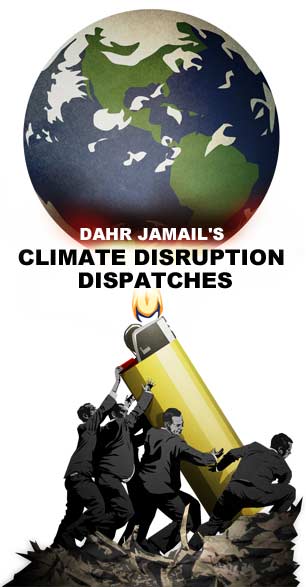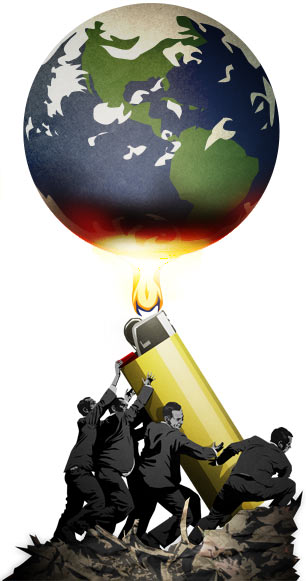Part of the Series
Climate Disruption Dispatches
Planet or Profit
Last year marked the 37th consecutive year of above-average global temperature, according to data from NASA.
The signs of advanced Anthropogenic Climate Disruption (ACD) are all around us, becoming ever more visible by the day.
At least for those choosing to pay attention.
An Abundance of Signs
While the causes of most of these signs cannot be solely attributed to ACD, the correlation of the increasing intensity and frequency of events to ACD is unmistakable.
Let’s take a closer look at a random sampling of some of the more recent signs.
Sao Paulo, South America’s largest city (over 12 million people), will see its biggest water-supply system run dry soon if there is no rain. Concurry, a town in Australia’s outback, is so dry after two rainless years that their mayor is now looking at permanent evacuation as a final possibility. Record temperatures in Australia have been so intense that in January, around 100,000 bats literally fell from the sky during an extreme heat wave.
A now-chronic drought in California, which is also one of the most important agricultural regions in the United States, has reached a new level of severity never before recorded on the US drought monitor in the state. In an effort to preserve what little water remained, state officials there recently announced they would cut off water that the state provides to local public water agencies that serve 25 million residents and about 750,000 acres of farmland. Another impact of the drought there has 17 communities about to run out of water. Leading scientists have discussed how California’s historic drought has been worsened by ACD, and a recent NASA report on the drought, by some measures the deepest in over a century, adds:
“The entire west coast of the United States is changing color as the deepest drought in more than a century unfolds. According to the US Dept. of Agriculture and NOAA, dry conditions have become extreme across more than 62% of California’s land area – and there is little relief in sight.
“Up and down California, from Oregon to Mexico, it’s dry as a bone,” comments JPL climatologst Bill Patzert. “To make matters worse, the snowpack in the water-storing Sierras is less than 20% of normal for this time of the year.”
“The drought is so bad, NASA satellites can see it from space. On Jan. 18, 2014 – just one day after California governor Jerry Brown declared a state of emergency – NASA’s Terra satellite snapped a sobering picture of the Sierra Nevada mountain range. Where thousands of square miles of white snowpack should have been, there was just bare dirt and rock.”
During a recent interview, a climate change scientist, while discussing ACD-induced drought plaguing the US Southwest, said that he had now become hesitant to use the word drought, because “the word drought implies that there is an ending.”
Meanwhile, New Mexico’s chronic drought is so severe the state’s two largest rivers are now regularly drying up. Summer 2013 saw the Rio Grande drying up only 18 miles south of Albuquerque, with the drying now likely to spread north and into the city itself. By September 2013, nearly half of the entire US was in moderate to extreme drought.
During a recent interview, a climate change scientist, while discussing ACD-induced drought plaguing the US Southwest, said that he had now become hesitant to use the word drought, because “the word drought implies that there is an ending.”
As if things aren’t already severe enough, the new report Hydraulic Fracturing and Water Stress: Water Demand by the Numbers shows that much of the oil and gas fracking activity in both the United States and Canada is happening in “arid, water stressed regions, creating significant long-term water sourcing risks” that will strongly and negatively impact the local ecosystem, communities and people living nearby.
The president of the organization that produced this report said, “Hydraulic fracturing is increasing competitive pressures for water in some of the country’s most water-stressed and drought-ridden regions. Barring stiffer water-use regulations and improved on-the-ground practices, the industry’s water needs in many regions are on a collision course with other water users, especially agriculture and municipal water use.”
Recent data from NASA shows that one billion people around the world now lack access to safe drinking water. Last year at an international water conference in Abu Dhabi, the UAE’s Crown Prince Sheikh Mohammed bin Zayed al-Nahyan said: “For us, water is [now] more important than oil.” Experts now warn that the world is “standing on a precipice” when it comes to growing water scarcity.
Looking northward, Alaska, given its Arctic geo-proximity, regularly sees the signs of advanced ACD. According to a recent NASA report on the northernmost US state:
“The last half of January was one of the warmest winter periods in Alaska’s history, with temperatures as much as 40°F (22°C) above normal on some days in the central and western portions of the state, according to Weather Underground’s Christopher Bart. The all-time warmest January temperature ever observed in Alaska was tied on January 27 when the temperature peaked at 62°F (16.7°C) at Port Alsworth. Numerous other locations – including Nome, Denali Park Headquarters, Palmer, Homer, Alyseka, Seward, Talkeetna, and Kotzebue – all set January records. The combination of heat and rain has caused Alaska’s rivers to swell and brighten with sediment, creating satellite views reminiscent of spring and summer runoff.”
Another recent study published in The Cryosphere shows that Alaska’s Arctic icy lakes are losing their thickness and fewer are freezing all the way through to the bottom during winter. This should not come as a surprise, given that the reflective capacity of Arctic sea ice has is disappearing at twice the rate previously shown.
 Polar bear on Bernard Harbor, along the Beaufort Sea coast, Arctic Alaska, June 2001. (Photo: Subhankar Banerjee)
Polar bear on Bernard Harbor, along the Beaufort Sea coast, Arctic Alaska, June 2001. (Photo: Subhankar Banerjee)
As aforementioned, science now shows that global temperatures are rising every year. In addition to this overall trend, we are now in the midst of a 28-year streak of summer records above the 20th century average.
In another indicator from the north, a new study by the UC Boulder Institute of Arctic and Alpine Research showed that average summer temperatures in the Eastern Canadian Arctic during the last 100 years are higher now than during any century in the past 44,000 years, and indications are that Canadian Arctic temperatures today have not been matched or exceeded for roughly 120,000 years. Research leader Gifford Miller added, “The key piece here is just how unprecedented the warming of Arctic Canada is. This study really says the warming we are seeing is outside any kind of known natural variability, and it has to be due to increased greenhouse gases in the atmosphere.”
 As ACD progresses, weather patterns come to resemble a heart-rate chart for a heart in defibrillation. Hence, rather than uniform increases in drought or temperatures, we are experiencing haphazard chaotic extreme weather events all over the planet, and the only pattern we might safely assume to continue is an intensification of these events, in both strength and frequency.
As ACD progresses, weather patterns come to resemble a heart-rate chart for a heart in defibrillation. Hence, rather than uniform increases in drought or temperatures, we are experiencing haphazard chaotic extreme weather events all over the planet, and the only pattern we might safely assume to continue is an intensification of these events, in both strength and frequency.
Iran’s Lake Urmia, once the largest lake in the country, has shrunk to less than half its normal size, causing Iran to face a crisis of water supply. The situation is so dire, government officials are making contingency plans to ration water in Tehran, a city of 22 million. Iran’s President Hassan Rouhani has even named water as a “national security issue,” and when he gives public speeches in areas impacted by water shortages he is now promising residents he will “bring the water back.”
In other parts of the world, while water scarcity is heightening already strained caste tensions in India, the UK is experiencing the opposite problems with water. January rains brought parts of England their wettest January since records began more than 100 years ago. The UK’s Met Office reported before the end of that month that much of southern England and parts of the Midlands had already seen twice the average rainfall for January, and there were still three days left in the month. January flooding across the UK went on to surpass all 247 years of data on the books, spurring the chief scientist at Britain’s Met Office to say that “all the evidence” suggests that the extreme weather in the UK is linked to ACD.
Another part of the world facing a crisis from too much water is Fiji, where residents from a village facing rising sea levels that are flooding their farmlands and seeping into their homes are having to flee. The village is the first to have its people relocated under Fiji’s “climate change refugee” program.
More bad news comes from a recently published study showing that Earth’s vegetation could be saturated with carbon by the end of this century, and would thus cease acting as a break on ACD.
More bad news comes from a recently published study showing that Earth’s vegetation could be saturated with carbon by the end of this century, and would thus cease acting as a break on ACD. However, this study could be an under-estimate of the phenomenon, as it is based on a predicted 4C rise in global temperature by 2100, and other studies and modeling predict a 4C temperature increase far sooner. (The Hadley Centre for Meteorological Research suggests a 4C temperature increase by 2060. The Global Carbon Project, which monitors the global carbon cycle, and the Copenhagen Diagnosis, a climate science report, predict 6C and 7C temperature increases, respectively, by 2100. The UN Environment Program predicts up to a 5C increase by 2050.)
Whenever we reach the 4C increase, whether it is by 2050, or sooner, this shall mark the threshold at which terrestrial trees and plants are no longer able to soak up any more carbon from the atmosphere, and we will see an abrupt increase in atmospheric carbon, and an even further acceleration of ACD.
And it’s not just global weather events providing the signs. Other first-time phenomena abound as well.
For the first time, scientists have discovered species of Atlantic Ocean zooplankton reproducing in Arctic waters. German researchers say the discovery indicates a possible shift in the Arctic zooplankton community as the region warms, one that could be detrimental to Arctic birds, fish, and marine mammals.
Another study shows an increase in both the range and risk for malaria due to ACD, and cat parasites have even been found in Beluga whales in the Arctic, in addition to recently published research showing other diseases in seals and other Arctic life.
Distressing signs of ACD’s increasing decimation of life continue unabated. In addition to between 150-200 species going extinct daily, Monarch butterflies are now in danger of disappearing as well. Experts recently reported that the numbers of Monarch butterflies have dropped to their lowest levels since record-keeping began. At their peak, the butterflies covered an area of Mexican pine and fir forests of 44.5 acres. Now, after steep and persistent declines in the last three years, they only cover 1.65 acres. Extreme weather trends, illegal logging, and a dramatic reduction of the butterflies’ habitat are all to blame.
A recently published study that spanned 27-years showed that ACD is “killing Argentina’s Magellanic penguin chicks.” Torrential rainstorms and extreme heat are killing the young birds in significant numbers.
Distressingly, the vast majority of these citations and studies are only from the last six weeks.
More Pollution, More Denial
Meanwhile, the polluting continues as global carbon emissions only continue to increase.
Another recent study shows that black carbon emissions in India and China could be two to three times more concentrated than previously estimated. Black carbon is a major element of soot, and comes from the incomplete combustion of fossil fuels. The study showed that parts of India and China could have as much as 130 percent higher black carbon concentrations than shown in standard country models.
India is now rated as having some of the worst air quality in the world, and is tied with China for exposing its population to hazardous air pollution.
Meanwhile, Australian government authorities recently approved a project that will dump dredged sediment near the Great Barrier Reef, a so-called World Heritage Site, to create one of the world’s largest coal ports.
Also on the front lines of the coal industry, miners now want to ignite deep coal seams to capture the gases created from the fires to use them for power generation. It’s called underground coal gasification, it is on deck for what comes next after the fracking blitz, and it is a good idea for those wishing to turn Earth into Venus.
Then we have BP’s “Energy Outlook” for the future, an annual report where the oil giant plots trends in global energy production and consumption. With this, we can expect nothing less than full steam ahead when it comes to vomiting as much carbon into the atmosphere in as short a time as possible.
BP CEO Bob Dudley announced at a January press conference that his company’s Outlook sees carbon emissions projected to rise “29% by 2035.”
Speaking of BP, the corporate-driven government of the United States continues to serve its masters well.
The US State Department recently released its environmental impact statement that found “no major climate impact” from a continuation in the construction of the Keystone XL pipeline, a pipeline that will transport tar sands oil – the dirtiest fossil fuel on Earth, produced by the most environmentally destructive fossil fuel extraction process ever known.
US President Barack Obama claims he has yet to make a decision on the pipeline, but we can guess what his decision shall be.
In late January, the US House Energy and Commerce Committee voted down an amendment that would have stated conclusively that ACD is occurring, despite recent evidence that ACD has literally shifted the jet stream, the main system that helps determine all of the weather in North America and Northern Europe. The 24 members of the committee who voted down the amendment, all of them Republicans and more overtly honest about who they are working for than is Obama, have accepted approximately $9.3 million in career contributions from the oil, gas, and coal industries.
Systemic problems require systemic solutions, and thinking the radical change necessary to preserve what life remains on the planet is possible without the complete removal of the system that is killing us, is futile.
The fact that the planet is most likely long past having gone over the cliff when it comes to passing the point of no return regarding ACD is a fact most people prefer not to contemplate.
And who can blame them? The relentless onslaught of distress signals from the planet, coupled with the fact that the governments of the countries generating the most emissions are those marching lock-step with the fossil fuel industries are daunting, to say the least.
Oil, gas, and coal are the fuels the capitalist system uses to generate the all-important next quarterly profit on the road toward infinite growth, as required by the capitalist system.
Systemic problems require systemic solutions, and thinking the radical change necessary to preserve what life remains on the planet is possible without the complete removal of the system that is killing us, is futile.
Half measures, as we have seen all too often, avail us nothing.
Join us in defending the truth before it’s too late
The future of independent journalism is uncertain, and the consequences of losing it are too grave to ignore. To ensure Truthout remains safe, strong, and free, we need to raise $43,000 in the next 6 days. Every dollar raised goes directly toward the costs of producing news you can trust.
Please give what you can — because by supporting us with a tax-deductible donation, you’re not just preserving a source of news, you’re helping to safeguard what’s left of our democracy.
